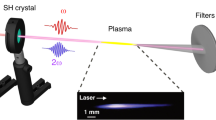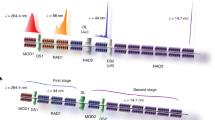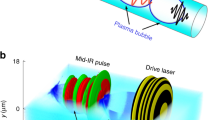Abstract
Mid-infrared ultrashort high energy laser sources are opening up new opportunities in science, including keV-class high harmonic generation and monoenergetic MeV-class proton acceleration. As new higher energy sources become available, potential applications for atmospheric propagation can dramatically grow to include stand-off detection, laser communications, shock-driven remote terahertz enhancement and extended long-lived thermal waveguides to transport high power microwave and radiofrequency waves. We reveal a new paradigm for long-range, low-loss, ultrahigh power ultrashort pulse propagation at mid-infrared wavelengths in the atmosphere. Before the onset of critical self-focusing, energy in the fundamental wave continually leaks into shock-driven spectrally broadened higher harmonics. A persistent near-invariant solitonic leading edge on the multi-terawatt pulse waveform transports most of the power over hundred-metre-long distances. Such light bullets are resistant to uncontrolled multiple filamentation and are expected to spark extensive research in optics, where the use of mid-infrared lasers is currently much under-utilized.
This is a preview of subscription content, access via your institution
Access options
Subscribe to this journal
Receive 12 print issues and online access
$209.00 per year
only $17.42 per issue
Buy this article
- Purchase on Springer Link
- Instant access to full article PDF
Prices may be subject to local taxes which are calculated during checkout






Similar content being viewed by others
References
Kasparian, J. et al. White-light filaments for atmospheric analysis. Science 301, 61–64 (2003).
Tzortzakis, S., Anglos, D. & Gray, D. Ultraviolet laser filaments for remote laser-induced breakdown spectroscopy (LIBS) analysis: applications in cultural heritage monitoring. Opt. Lett. 31, 1139–1141 (2006).
Stelmaszczyk, K. et al. Long-distance remote laser-induced breakdown spectroscopy using filamentation in air. Appl. Phys. Lett. 85, 3977–3979 (2004).
Alfano, R. R. & Shapiro, S. L. Observation of self-phase modulation and small-scale filaments in crystals and glasses. Phys. Rev. Lett. 24, 592–594 (1970).
Ackermann, R. et al. Influence of negative leader propagation on the triggering and guiding of high voltage discharges by laser filaments. Appl. Phys. B 82, 561–566 (2006).
Zhao, X. M., Diels, J.-C., Wang, C. Y. & Elizondo, J. M. Femtosecond ultraviolet laser pulse induced lightning discharges in gases. IEEE J. Quantum Electron. 31, 599–612 (1995).
Comtois, D. et al. Triggering and guiding leader discharges using a plasma channel created by an ultrashort laser pulse. Appl. Phys. Lett. 76, 819–821 (2000).
Kasparian, J. et al. Electric events synchronized with laser filaments in thunderclouds. Opt. Express 16, 5757–5763 (2008).
Rohwetter, P. et al. Laser-induced water condensation in air. Nature Photon. 4, 451–456 (2010).
Couairon, A. & Mysyrowicz, A. Femtosecond filamentation in transparent media. Phys. Rep. 441, 47–189 (2007).
Mechain, G. et al. Range of plasma filaments created in air by a multi-terawatt femtosecond laser. Opt. Commun. 247, 171–180 (2005).
Mlejnek, M., Wright, E. M. & Moloney, J. V. Dynamic spatial replenishment of femtosecond pulses propagating in air. Opt. Lett. 23, 382–384 (1998).
Mechain, G., Couairon, A., Franco, M., Prade, B. & Mysyrowicz, A. Organizing multiple femtosecond filaments in air. Phys. Rev. Lett. 93, 035003 (2004).
Mlejnek, M., Kolesik, M., Moloney, J. V. & Wright, E. M. Optically turbulent femtosecond light guide in air. Phys. Rev. Lett. 83, 2938–2941 (1999).
Mills, M. S., Kolesik, M. & Christodoulides, D. N. Dressed optical filaments. Opt. Lett. 38, 25–27 (2013).
Scheller, M. et al. Externally refuelled optical filaments. Nature Photon. 8, 297–301 (2014).
Point, G. et al. Superfilamentation in air. Phys. Rev. Lett. 112, 223902 (2014).
Mechain, G. et al. Long-range self-channeling of infrared laser pulses in air: a new propagation regime without ionization. Appl. Phys. B 79, 379–382 (2004).
Durand, M. et al. Kilometer range filamentation. Opt. Express 21, 26836–26845 (2013).
Shim, B., Schrauth, S. E. & Gaeta, A. L. Filamentation in air with ultrashort mid-infrared pulses. Opt. Express 19, 9118–9126 (2011).
Kartashov, D. et al. White light generation over three octaves by femtosecond filament at 3.9 μm in argon. Opt. Lett. 37, 3456–3458 (2012).
Cheng, M., Reynolds, A., Widgren, H. & Khalil, M. Generation of tunable octave-spanning mid-infrared pulses by filamentation in gas media. Opt. Lett. 37, 1787–1789 (2012).
Nomura, Y. et al. Phase-stable sub-cycle mid-infrared conical emission from filamentation in gases. Opt. Express 20, 24741–24747 (2012).
Kartashov, D. et al. Mid-infrared laser filamentation in molecular gases. Opt. Lett. 38, 3194–3197 (2013).
Bergé, L., Rolle, J. & Köhler, C. Enhanced self-compression of mid-infrared laser filaments in argon. Phys. Rev. A 88, 023816 (2013).
Skupin, S. & Bergé, L. Supercontinuum generation of ultrashort laser pulses in air at different central wavelengths. Opt. Commun. 280, 173–182 (2007).
Bergé, L. Self-compression of 2 µm laser filaments. Opt Express 16, 21529–21543 (2008).
Bespalov, V. I. & Talanov, V. I. Filamentary structure of light beams in nonlinear liquids. JETP Lett. 3, 307–310 (1966).
Akozbek, N. et al. Third-harmonic generation and self-channeling in air using high-power femtosecond laser pulses. Phys. Rev. Lett. 89, 143901 (2002).
Popmintchev, T. et al. Bright coherent ultrahigh harmonics in the keV X-ray regime from mid-infrared femtosecond lasers. Science 336, 1287–1291 (2012).
Palmer, C. A. J. et al. Monoenergetic proton beams accelerated by a radiation pressure driven shock. Phys. Rev. Lett. 106, 014801 (2011).
Hernández-García, C. et al. Zeptosecond high harmonic keV X-ray waveforms driven by midinfrared laser pulses. Phys. Rev. Lett. 111, 033002 (2013).
Mitrofanov, A. V. et al. Mid-infrared laser filaments in the atmosphere. Sci. Rep. 5, 8368 (2015).
Korteweg, D. J. & de Vries, G. XLI . On the change of form of long waves advancing in a rectangular canal, and on a new type of long stationary waves. Phil. Mag. 39, 422–443 (1895).
Zabusky, N. J. & Kruskal, M. D. Interaction of ‘solitons’ in a collisionless plasma and the recurrence of initial states. Phys. Rev. Lett. 15, 240–243 (1965).
Whitham, G. B. Linear and Nonlinear Waves (Wiley, 1974).
Rosen, G. Electromagnetic shocks and the self-annihilation of intense linearly polarized radiation in an ideal dielectric material. Phys. Rev. 139, A539–A543 (1965).
Flesch, R. G., Pushkarev, A. & Moloney, J. V. Carrier wave shocking of femtosecond optical pulses. Phys. Rev. Lett. 76, 2488–2491 (1996).
Kinsler, P., Radnor, S. B. P., Tyrrell, J. C. A. & New, G. H. C. Optical carrier wave shocking: detection and dispersion. Phys. Rev. E 75, 066603 (2007).
Kozlov, S. A. & Sazonov, S. V. Nonlinear propagation of optical pulses of a few oscillations duration in dielectric media. J. Exp. Theor. Phys. 84, 221–228 (1997).
Whalen, P., Panagiotopoulos, P., Kolesik, M. & Moloney, J. V. Extreme carrier shocking of intense long-wavelength pulses. Phys. Rev. A 89, 023850 (2014).
Kolesik, M. & Moloney, J. V. Nonlinear optical pulse propagation simulation: from Maxwell's to unidirectional equations. Phys. Rev. E 70, 036604 (2004).
Couairon, A. et al. Practitioner's guide to laser pulse propagation models and simulation. Eur. Phys. J. Spec. Top. 199, 5–76 (2011).
Wahlstrand, J., Cheng, Y.-H. & Milchberg, H. M. Absolute measurement of the transient optical nonlinearity in N2, O2, N2O, and Ar. Phys. Rev. A 85, 043820 (2012).
Peck, E. R. & Reeder, K. Dispersion of air. J. Opt. Soc. Am. 62, 958–962 (1972).
Keldysh, L. V. Ionization in the field of a strong electromagnetic wave. Sov. Phys. JETP 20, 1307–1314, (1965).
Mishima, K. et al. Generalization of Keldysh's theory. Phys. Rev. A 66, 033401 (2002).
Acknowledgements
This work was supported by an Air Force Office of Scientific Research Multidisciplinary University Research Initiative (MURI; grant no. FA9550-10-1-0561).
Author information
Authors and Affiliations
Contributions
All authors contributed to the development and/or implementation of the concept. P.P., P.W. and M.K. performed the numerical simulations and J.V.M. supervised the research. All authors contributed to the discussion of the results and to the writing of the manuscript.
Corresponding author
Ethics declarations
Competing interests
The authors declare no competing financial interests.
Supplementary information
Supplementary information
Supplementary information (PDF 1246 kb)
Supplementary information
Supplementary information Movie 1 (MOV 4555 kb)
Supplementary information
Supplementary information Movie 2 (MOV 11415 kb)
Supplementary information
Supplementary information Movie 3 (MOV 3537 kb)
Rights and permissions
About this article
Cite this article
Panagiotopoulos, P., Whalen, P., Kolesik, M. et al. Super high power mid-infrared femtosecond light bullet. Nature Photon 9, 543–548 (2015). https://doi.org/10.1038/nphoton.2015.125
Received:
Accepted:
Published:
Issue Date:
DOI: https://doi.org/10.1038/nphoton.2015.125
This article is cited by
-
Controlling two-photon emission from superluminal and accelerating index perturbations
Nature Physics (2022)
-
Wavelength scaling of electron collision time in plasma for strong field laser-matter interactions in solids
Communications Physics (2021)
-
Structured 3D linear space–time light bullets by nonlocal nanophotonics
Light: Science & Applications (2021)
-
Powerful terahertz waves from long-wavelength infrared laser filaments
Light: Science & Applications (2020)
-
Frontiers in multidimensional self-trapping of nonlinear fields and matter
Nature Reviews Physics (2019)



